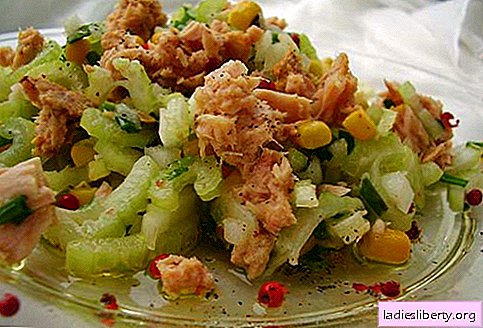
Berry bushes are grown to produce juicy and healthy fruits, gooseberries are no exception.
To ensure good productivity of the bush will help only high-quality care.
Particular attention should be paid to the berry in the fall, because not only its health, but also the future harvest depends on the quality preparation of the gooseberry for the winter.
What care does gooseberries need in the fall?
It all depends on the condition of the plant. The shrub that has been looked after throughout the season needs minimal maintenance. After all, a healthy plant is able to independently resist all diseases and pests, tolerates cold well. In this case, the main task of the gardener becomes feeding and thinning the bush.
If the gooseberry is running, then before the cold weather begins, the following work must be done:
• remove all weeds around the bush;
• clean the garbage and remove the foliage from the site;
• carry out control treatment from pests and diseases;
• dig the soil under the bushes;
• make additional fertilizers;
• cut the shoots, thin out the bush;
• mulch the root zone with the onset of cold weather.
Gooseberry Care: Autumn Treatments
It is useful for beginning gardeners to know how to prepare gooseberries for the winter in stages.
Aisle cultivation and weeding
Shrub prefers loose soil. Only in this case can a good crop be harvested. Weeds must be fought throughout the season, preventing their appearance near the plant.
Important! Herbicides must not be used to control weeds. Weeds are harvested only by hand.
Experienced gardeners are advised to keep the soil under the berry in a clean condition, planting flowers or lawn grasses is not allowed. Additionally, loosening the soil will help weeding. It is combined with weed harvesting.
Noticed that autumn digging around the bushes helps to cope with a number of diseases and pests. This is due to the fact that pathogens and pest larvae winter in the ground, and digging allows them to be raised to the surface where they die. It is necessary to carry out the procedure in late autumn, when frosty weather has established.
Why mulch gooseberries?
If it is not possible to often come to the cottage, then mulch will help to maintain the soil in the necessary state. The need for regular weeding and watering is reduced.
Gooseberries are good for mulching. As mulch, humus or ripened compost is used. These materials provide additional nutrition for the shrub.
The thickness of the mulching layer depends on the season and the condition of the shrub. Autumn mulch serves as a shelter from frost. Its thickness is 10 cm.
Gooseberry top dressing in the fall
The last autumn top dressing is carried out after loosening and digging the soil. It helps replenish plant supplies with nutrients, which affects yield. During this period, it is advisable to use phosphorus and potash fertilizers. Nitrogen feeding is not used in autumn. Mineral fertilizers are applied according to the scheme:
• 30 g of superphosphate;
• 20 g of potassium sulfate;
• 100 g of ash.
This amount of fertilizer is designed for one bush. Top dressing is applied both in liquid and in dry form. Granular fertilizers must be embedded in the soil.
Late autumn shrub irrigation
At the stage of preparing gooseberries for winter, we must not forget about late autumn irrigation. It serves to saturate the berry with moisture. After all, the roots of the plant go far deeper. In order for all moisture to go to the roots of the plant, you need to make grooves along which watering will be carried out. At the same time, water consumption is 30 liters per bush. Such water-charging irrigation is done at the end of September, but not later than the beginning of October. In the northern regions a little earlier, a month before the onset of frost.
Important! You can not neglect late watering. This will reduce shrub yields. Indeed, young shoots, on which fruits are formed, suffer from a lack of moisture.
When caring for gooseberries and preparing them for winter, it is also important to remember about pruning and thinning shrubs. Its main task is to rid the bush of all unnecessary branches that lead to thickening and disease. You need to remove all broken, old, diseased and growing branches inside the bush. Particular attention needs to be removed from the bottom of the shrub. All shoots that lie on the ground are subject to removal.

In the fall, formative pruning is performed. Several developed shoots are left on the shrub, and the rest are removed at the soil level. You also need to cut out all the non-fruiting and old shoots. Too long branches can be shortened by a third.
Preparing for Winter: Gooseberry Shelter
In the conditions of the southern and middle stripes, additional shrub shelter is not required in addition to mulching. But in the northern regions: in the Urals, in Siberia, this issue needs to be approached thoroughly.
In harsh winters, without additional shelter, the plant simply will not survive. After all, gooseberries can not tolerate lowering temperatures to -40 degrees. Hoping for a warm winter and risking a bush is not worth it. Gooseberry shoots must be carefully tied with twine and bent to the ground obliquely. Further, the bush is covered with dry leaves or peat. Wooden shields are installed on top and covered with burlap or covering material. When winter comes, gooseberries are additionally insulated, falling asleep with snow.

The preparation and sheltering of gooseberries is carried out no later than the end of September, after watering the berry to saturate it with moisture.
In early spring, shelter from the bush must be removed, untie the twine. In a few days, he will take the right position, independently straightening the shoots.
This scheme of gooseberry shelter in the northern regions will help save the plant, and increase the yield.
What a gardener needs to know when growing gooseberries
Powdery Mildew on Gooseberries
Frequent watering of gooseberries on the leaves leads to an increase in humidity around the plant, which is a favorable environment for the development of fungal diseases.
Powdery mildew is found on the shoots and fruits of the berry, less often on the leaves. At the initial stage of the defeat, you can see a thin web, which eventually turns into a felt coating on the berries. At the same time, the leaves of the plant turn yellow before time, the fruits fall off, and the yield decreases.
Preventive measures that are taken in the fall and spring will help prevent the disease. The bush is treated with soda ash. All affected fruits must be destroyed. In autumn, the bush is sprayed with preparations containing copper. Autumn digging of soil on frozen ground helps a lot.
Leaf aphids
Of the pests, the aphid most often annoys the plant. She settles on young shoots and leaves of the plant, which curl up and slow down their growth. As a result, the development of shrubs slows down, and productivity decreases.
Aphid colonies settle on the underside of the leaf, where it is easy to detect. Also on the surface of the leaf plate, you can notice a sticky coating left by an insect. At the first signs of pests, measures must be taken immediately to eliminate it.
If the lesion is not too strong, then use a soap solution with which the bush is sprayed. With a large number of pests, spraying is carried out with chemical preparations:
• Actellik;
• kalbofos.
To summarize
Gooseberries are a long-lived garden. With proper care, it can grow long enough in one place, regularly pleasing with a good harvest.











